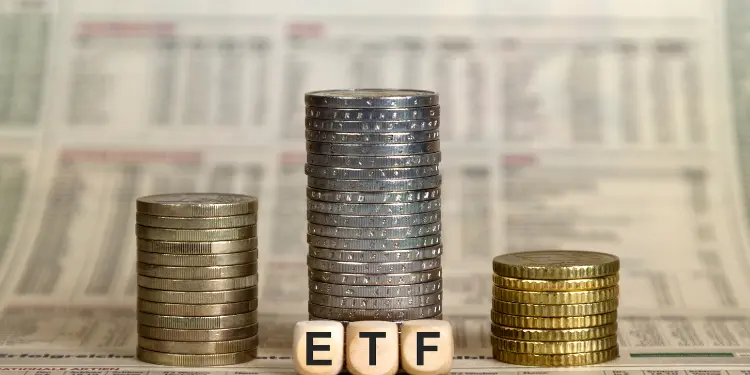As the cryptocurrency market continues to evolve, more traditional financial instruments are emerging to bridge the gap between digital assets and mainstream investors. One of the most talked-about developments in this space is the Bitcoin ETF. But what is Bitcoin ETF, and why has it generated so much interest from institutional and retail investors alike? In this article, we’ll break down everything you need to know about Bitcoin ETFs, including their types, benefits, risks, and impact on the broader crypto market.
What is Bitcoin ETF?

A Bitcoin ETF (Exchange-Traded Fund) is a type of investment fund that tracks the price of Bitcoin. Instead of buying and storing Bitcoin directly, investors can gain exposure to its price movements through a regulated, stock exchange-listed financial product. This makes it easier for traditional investors to include Bitcoin in their portfolios without dealing with private keys, wallets, or crypto exchanges.
When Did Bitcoin ETF Start?
The concept of a Bitcoin ETF has been around for over a decade. However, the first significant breakthrough came in October 2021 with the approval of the Bitcoin Futures ETF by the U.S. Securities and Exchange Commission (SEC). The launch of this fund marked a pivotal moment in Bitcoin’s journey toward institutional acceptance.
More recently, in January 2024, the SEC approved the first Bitcoin Spot ETFs, which directly track the market price of Bitcoin rather than futures contracts. This development was widely celebrated as a major milestone for cryptocurrency adoption.
Types of Bitcoin ETFs
There are several types of Bitcoin ETFs currently available:
1. Bitcoin Spot ETF
A Bitcoin Spot ETF is backed by actual Bitcoin holdings. The fund purchases Bitcoin and stores it in secure custodial wallets, giving investors exposure to real-time market prices. These ETFs are considered more accurate in reflecting Bitcoin’s performance.
2. Bitcoin Futures ETF
A Bitcoin Futures ETF tracks futures contracts instead of actual Bitcoin. Futures are agreements to buy or sell Bitcoin at a predetermined price on a specific date. While regulated and widely accepted, futures ETFs may not perfectly track Bitcoin’s spot price due to factors like contango and backwardation.
Benefits of Investing in a Bitcoin ETF
- Ease of Access: Investors can buy and sell shares of a Bitcoin ETF using traditional brokerage accounts.
- Regulatory Oversight: ETFs operate under financial regulations, offering a sense of security and compliance.
- No Need for Crypto Wallets: There is no need to manage private keys or use cryptocurrency exchanges.
- Portfolio Diversification: Bitcoin ETFs can help diversify a portfolio by including exposure to digital assets.
Risks and Limitations
- Tracking Errors: Especially with Bitcoin futures ETFs, prices may deviate from the actual market price.
- Management Fees: ETFs typically charge fees, which can reduce overall returns.
- Volatility: Bitcoin is highly volatile, and ETF performance reflects this risk.
- Regulatory Uncertainty: Changing regulations can impact the ETF market.
Bitcoin ETF Price Movements
Like any ETF, the Bitcoin ETF price fluctuates based on the performance of the underlying asset—in this case, Bitcoin. However, factors like trading volume, investor demand, and ETF structure (spot or futures) can also influence price performance.
For instance, spot ETFs tend to mirror Bitcoin’s price more closely than futures ETFs, which may experience slippage due to contract expiration and rollover costs.
The Road to Bitcoin ETF Approval
Gaining Bitcoin ETF approval has been a long and complex journey. The SEC initially rejected several applications citing market manipulation risks and investor protection concerns. However, increasing institutional interest and the maturation of the crypto market eventually led to regulatory green lights.
The approval of spot Bitcoin ETFs in 2024 by the SEC is considered a landmark event that opened doors for greater participation by large asset managers and retail investors.
Bitcoin Spot ETFs Inflows: A Bullish Signal?
Following their approval, Bitcoin spot ETFs inflows have seen significant momentum. Inflows represent the total funds entering these ETFs, often indicating investor confidence and bullish sentiment.
For example, major asset managers like BlackRock and Fidelity launched spot Bitcoin ETFs, attracting billions in investment within weeks. These inflows not only impact ETF performance but also contribute to Bitcoin’s upward price trends by increasing demand for actual Bitcoin.
The Impact of Bitcoin ETFs on the Market
Bitcoin ETFs have had a considerable impact on both the crypto and traditional financial markets:
- Mainstream Adoption: ETFs help legitimize Bitcoin as a viable asset class.
- Increased Liquidity: ETFs contribute to higher trading volumes and market depth.
- Price Stability: Institutional involvement through ETFs may reduce wild price swings over time.
- Education and Awareness: Broader access leads to more public interest and understanding of Bitcoin.
Conclusion
With the recent approval of spot ETFs and growing market inflows, Bitcoin ETFs are quickly becoming a cornerstone of crypto investing.
Whether you’re a seasoned investor or just getting started, understanding how Bitcoin ETFs work—and the differences between spot, futures, and short ETFs—can help you make more informed investment decisions.
As the regulatory landscape continues to evolve, staying updated on bitcoin ETF price trends and market movements will be crucial. The rise of Bitcoin ETFs is not just a trend—it’s a signal that crypto is entering the mainstream investing world.












